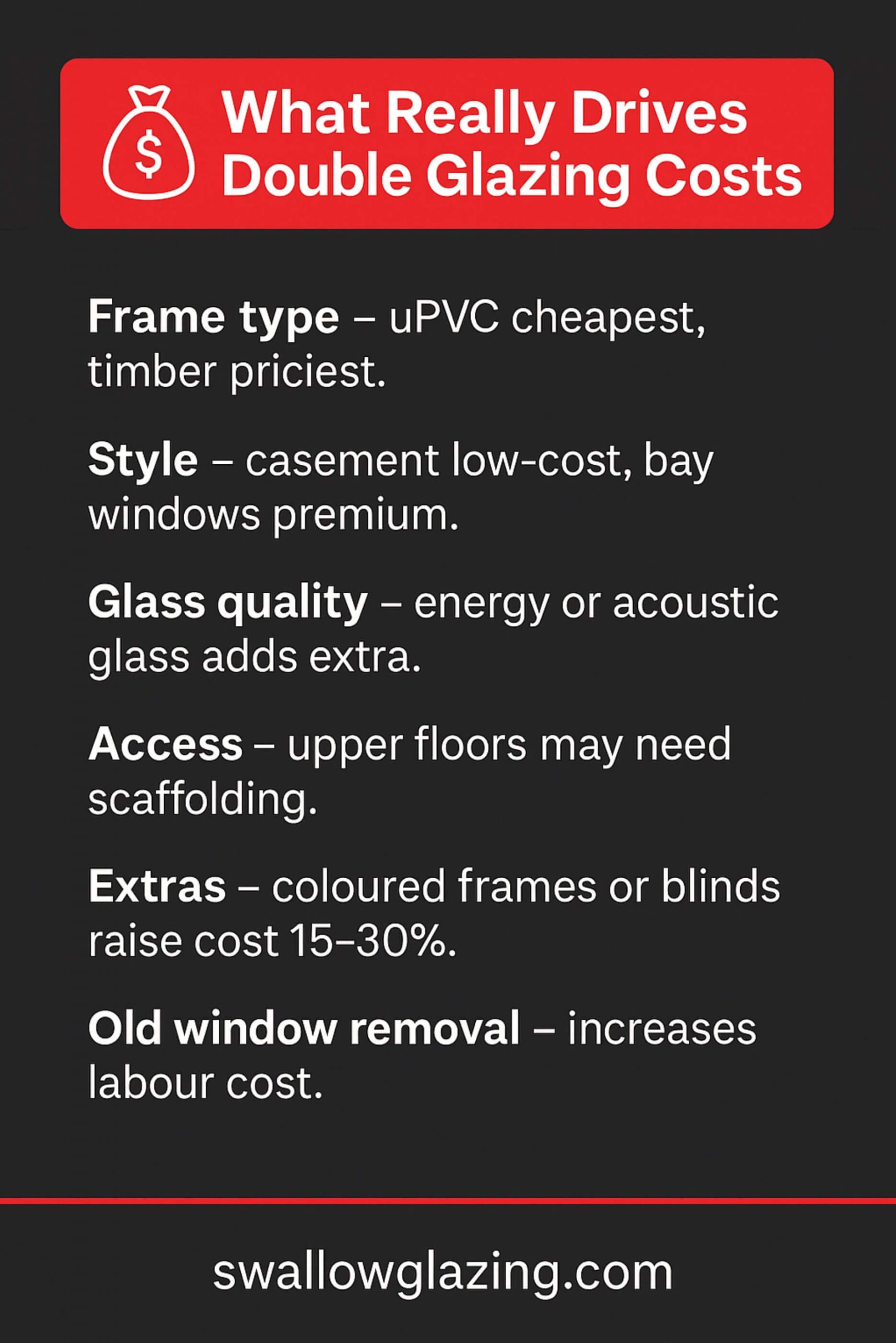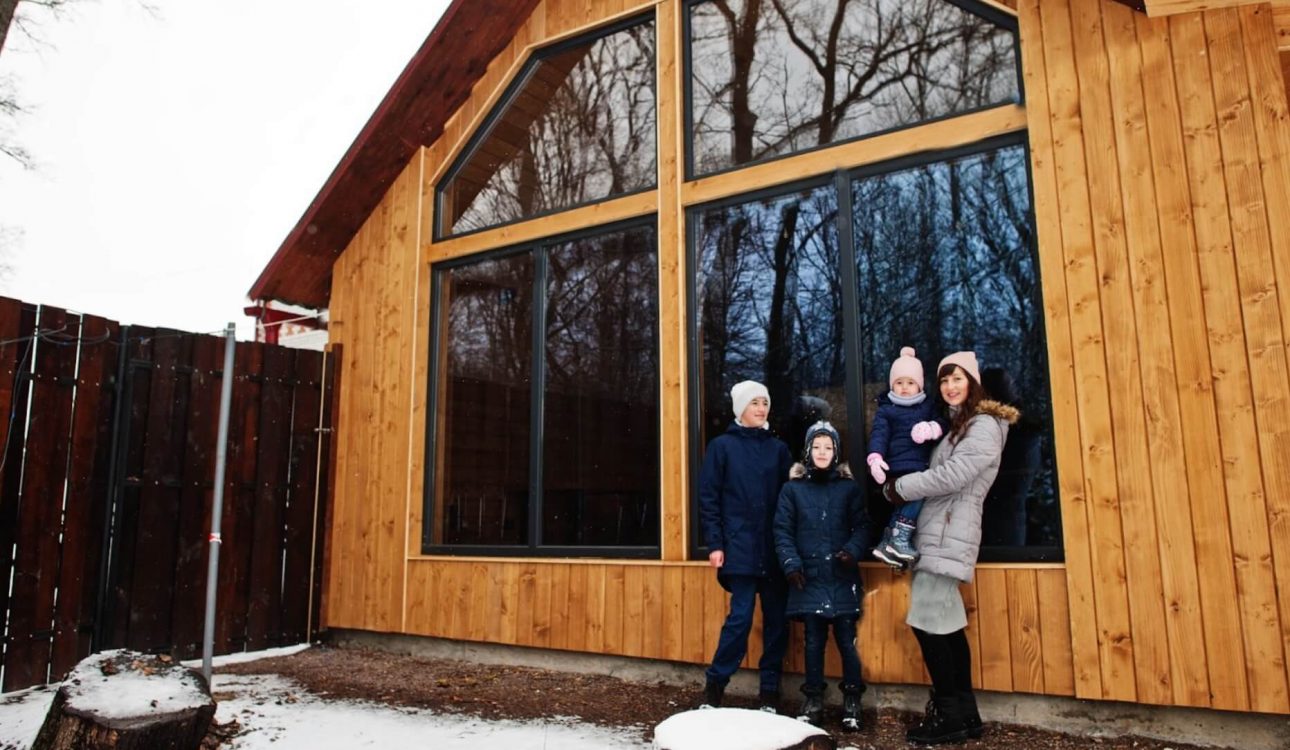Double glazing a 3-bed UK house in 2025 typically costs £6,500-£13,000 for 9-12 windows, including installation. Prices vary based on window style, frame material (uPVC, aluminium, timber), and property type.
Thinking about replacing the windows in your 3-bed home? Smart move. New double glazing can transform your property, boost energy efficiency, and add value. But what will it cost in 2025? This guide breaks down everything you need to know about current prices, factors affecting costs, and how to budget effectively for your window replacement project.
Key Takeaways
- Window frame material significantly impacts cost; uPVC starts at £550 per window, while aluminium and timber cost 25% and 50% more, respectively.
- Property type matters; terraced houses (8 windows) cost £4,400-£8,800, while detached homes (10-12 windows) run £5,500-£13,200+.
- Though the financial payback period exceeds 40 years, double glazing immediately improves comfort and can increase property value by up to 10%.
Average Cost of Double Glazing for a 3-Bed House in the UK (2025)
The typical cost to fully double glaze a standard 3-bedroom house in the UK now ranges from £6,500 to £13,000, including VAT and installation. This price covers a complete job with 9-12 windows using A/B-rated energy-efficient glass.
Most quotes in 2025 for standard white uPVC casement windows fall between £550 and £1,100 per window. This variation reflects differences in window size, style, and installation complexity.
What’s included in this price range? Typically, you get:
- Supply and fitting of new windows
- A/B-rated double glazing (meeting current building regulations)
- Removal and disposal of old windows
- Making good around frames
- VAT
The cost has seen modest increases compared to 2024, with official statistics showing producer output prices rising by approximately 3.4% year-on-year as of September 2025.
Cost by House Type and Number of Windows
The total price naturally depends on how many windows your home has. Different property types typically require different numbers of window units:
- Terraced Houses: Usually have around 8 windows, costing £4,400-£8,800 for standard uPVC.
- Semi-Detached Houses: Typically feature 9-10 windows, with costs around £5,000-£11,000.
- Detached Houses: Generally have 10-12 windows or more, pushing costs to £5,500-£13,200+.
Many 3-bed homes also feature bay windows, which significantly affect pricing. A standard bay window counts as multiple units (usually 3 panes), effectively tripling the cost of a single window for that opening.
Upper floor windows often require scaffolding or access equipment, adding £300-£800 to your total depending on the scale of work required.
Cost Differences by Frame Material and Window Style
Frame Materials
The choice of frame material has the biggest impact on your overall cost:
| Frame Material | Cost Per Window | Material Premium | Typical Total (10 windows) |
|---|---|---|---|
| uPVC (white) | £550-£1,100 | Base price | £6,500-£9,000 |
| Aluminium | £700-£1,375 | +25% over uPVC | £10,500-£14,500 |
| Timber | £825-£1,650 | +50% over uPVC | £12,500-£18,000 |
uPVC remains the most affordable and popular option in the UK. It requires minimal maintenance and offers excellent thermal performance. White uPVC frames are the most economical, with coloured finishes adding 10-15% to the cost.
Aluminium provides a sleeker, more contemporary look with thinner frames that allow more light. Modern thermally broken aluminium frames perform much better than older versions but come at a premium.
Timber frames offer traditional aesthetics and environmental benefits. Factory-finished softwood sits at the lower end of the timber price range, while hardwood options like oak can push costs toward the upper limit.
Window Styles
Different window styles also affect your final bill:
| Window Style | uPVC Cost Range | Description |
|---|---|---|
| Casement | £550-£900 | Hinged at side, most common & affordable |
| Tilt & Turn | £650-£1,000 | Opens inward, dual-function mechanism |
| Sash | £750-£1,200 | Vertical sliding sections, traditional |
| Bay | £1,650-£2,700 | Projecting window unit (3 sections) |
Our double glazing service in Uxbridge offers all these styles with professional installation to suit your property’s needs.
What Factors Affect the Cost of Double Glazing?
Multiple factors influence the final price tag when double glazing your 3-bed house.

Cost Breakdown: Real-Life Examples
Let’s look at some realistic examples for different 3-bed house types in 2025:
Example 1: 3-bed terraced house with 8 windows
- 7 standard casement windows (white uPVC): £4,200
- 1 bay window (3 sections, white uPVC): £1,800
- Removal and disposal of old windows: £400
- Total project cost: £6,400
Example 2: 3-bed semi-detached with 10 windows
- 8 casement windows (cream woodgrain uPVC): £6,400
- 1 bay window (3 sections, cream woodgrain uPVC): £2,100
- 1 small bathroom window: £500
- Scaffolding for upper floor access: £400
Example 3: 3-bed detached with 12 windows
- 10 casement/tilt windows (aluminium): £8,500
- 2 large picture windows: £3,000
- Building regulations compliance: £200
- Removal and disposal: £600
- Total project cost: £12,300
How to Get the Best Value for Your Double Glazing
Finding good value doesn’t mean choosing the cheapest quote. Here’s how to ensure quality while managing costs:
- Get multiple quotes. Aim for at least three detailed quotes from different companies to compare pricing and specifications. Ensure each quote specifies the exact window measurements, frame materials, glass type, and energy ratings.
- Check credentials. Choose FENSA or CERTASS-registered installers who can self-certify compliance with building regulations. This saves you separate local authority building control fees (£120-£300) and provides certification essential when selling your property.
- Specify details upfront. Be clear about requirements for trickle vents (now mandatory in most locations), safety glazing for critical locations, and any acoustic or thermal preferences.
- Consider timing. Many installers offer better rates during quieter seasons (typically November-February). Booking several months ahead can sometimes secure better pricing.
- Check energy ratings. All replacement windows must now achieve either a minimum U-value of 1.4 W/m²K or a Window Energy Rating (WER) of Band B or better to comply with current building regulations.
- Ask about extras. Scaffolding, making good, and waste disposal should be included in quotes. Clarify these points to avoid surprise charges later.
Energy Savings and Payback Period
Quality double glazing significantly reduces heat loss through windows, potentially saving around £100-£150 annually on heating bills for a typical 3-bed house.
With installation costs starting around £6,500, the pure financial payback period is lengthy (40+ years). However, most homeowners value the immediate comfort benefits, noise reduction, and condensation prevention alongside the energy savings.
Double glazing also enhances your home’s EPC rating, potentially increasing property value by 10% according to some estate agents. This improved marketability often represents the most significant financial return.
Get a Personalised Quote
Every home is unique, which means the best way to get an accurate price for your 3-bed property is through a personalised quotation. We provide free, no-obligation quotes tailored to your specific requirements and property type. Our FENSA-registered team can advise on the most cost-effective solutions while ensuring compliance with all current regulations. Contact us today at Swallow Glazing to arrange your free consultation and detailed quotation.
FAQs
How much does it cost to replace one double-glazed window?
Replacing a single standard-sized window costs £550-£1,100 for uPVC, £690-£1,375 for aluminium, and £825-£1,650 for timber. Single replacements typically cost more per unit than full-house installations.
Is uPVC still the best value for UK homes in 2025?
Yes, uPVC remains the most cost-effective option with excellent thermal performance. Modern uPVC frames offer improved aesthetics and longer guarantees than earlier generations.
Do I need planning permission to replace my windows?
Generally, no, unless your property is listed or in a conservation area. However, all replacements must comply with current building regulations, which is why using FENSA-registered installers is recommended.
Are there any UK grants or schemes for energy-efficient windows?
Limited support is available through the ECO4 scheme for low-income households, but typically only when windows form part of a whole-house improvement package. The Great British Insulation Scheme rarely covers glazing.
Do double-glazed windows add value when selling a house?
Yes, quality double glazing typically adds 5-10% to property value while making homes more attractive to potential buyers. FENSA certificates provide reassurance during the conveyancing process.



